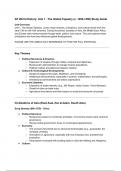AP World History: Unit 1 - The Global Tapestry (c. 1200-1450) Study Guide
Unit Overview:
Unit 1, The Global Tapestry, covers major empires, civilizations, and cultural trends from the
early 13th to mid-15th centuries. During this period, societies in Asia, the Middle East, Africa,
and Europe were interconnected through trade, politics, and culture. This unit explores these
civilizations and how they influenced global developments.
PLEASE USE THE AMSCO AS A REFERENCE TO THIS FOR FULL POTENTIAL
Key Themes
1. Political Structures & Empires:
○ Expansion of empires through military conquest and diplomacy.
○ Bureaucratic administration to manage diverse populations.
○ Political rivalries and alliances between empires.
2. Cultural & Technological Developments:
○ Spread of religions like Islam, Buddhism, and Christianity.
○ Intellectual advancements, especially in science, mathematics, and philosophy.
○ Architectural achievements and artistic expressions.
3. Economic Systems:
○ Expansion of trade networks (e.g., Silk Roads, Indian Ocean, Trans-Saharan).
○ Growth of cities as trade hubs.
○ Agricultural innovations and their impact on social and economic structures.
Civilizations of Asia (East Asia, Dar al-Islam, South Asia)
Song Dynasty (960-1279) - China
● Political Structure:
○ Bureaucracy based on Confucian principles. Civil service exams were central to
governance.
○ Strong central government; focus on merit-based appointments.
● Economy:
○ The economy flourished due to advanced technologies (e.g., gunpowder, the
compass, printing).
○ Innovations in agriculture, especially with rice (Champa rice), boosted food
production.
○ Urbanization increased with bustling trade in cities like Kaifeng and Hangzhou.
● Culture:
, ○ Neo-Confucianism became prominent, blending Confucian values with Buddhist
and Daoist elements.
○ The development of poetry, painting, and ceramics flourished under Song rule.
○ Chinese culture influenced it tributary states such as Korea and Vietnam, and
also Japan.
Abbasid Caliphate (750-1258) - Middle East
● Political Structure:
○ Abbasid Caliphate maintained a vast empire, centered in Baghdad, until its
decline due to internal strife and external invasions (e.g., Mongols).
○ Important: represented a shift from Arab to Turkic dominated Islamic powers.
○ A bureaucracy facilitated governance over the diverse Islamic world.
● Economy & Trade:
○ Baghdad was a major center of learning, trade, and culture.
○ Islamic merchants dominated trade across Afro-Eurasia, facilitating exchanges of
goods, technologies, and ideas.
○ Agricultural production thrived, and commercial activity was bolstered by the
establishment of banking systems and letters of credit.
● Cultural Developments:
○ The Golden Age of Islam brought advancements in mathematics (algebra),
astronomy, and medicine.
○ Islamic scholars preserved and expanded on Greek, Persian, and Indian
knowledge.
○ Architecture flourished, exemplified by the Great Mosque of Samarra.
Delhi Sultanate (1206-1526) - India
● Political Structure:
○ Established Muslim rule over large parts of the Indian subcontinent, with a capital
in Delhi.
○ Often ruled by Turkic and Afghan dynasties, leading to the cultural integration of
Islam and Hinduism.
○ Delhi Rulers were significantly intolerant to the Hindu subjects they ruled.
● Economy:
○ A key player in the Indian Ocean trade network, with exports like textiles, spices,
and precious stones.
○ The Delhi Sultanate helped promote economic growth through improved
infrastructure and the spread of trade.
● Cultural Contributions:
○ Islamic architecture influenced Indian styles (e.g., Qutb Minar).
○ The blending of Persian, Turkic, and Indian traditions led to the emergence of
new artistic and cultural forms.




